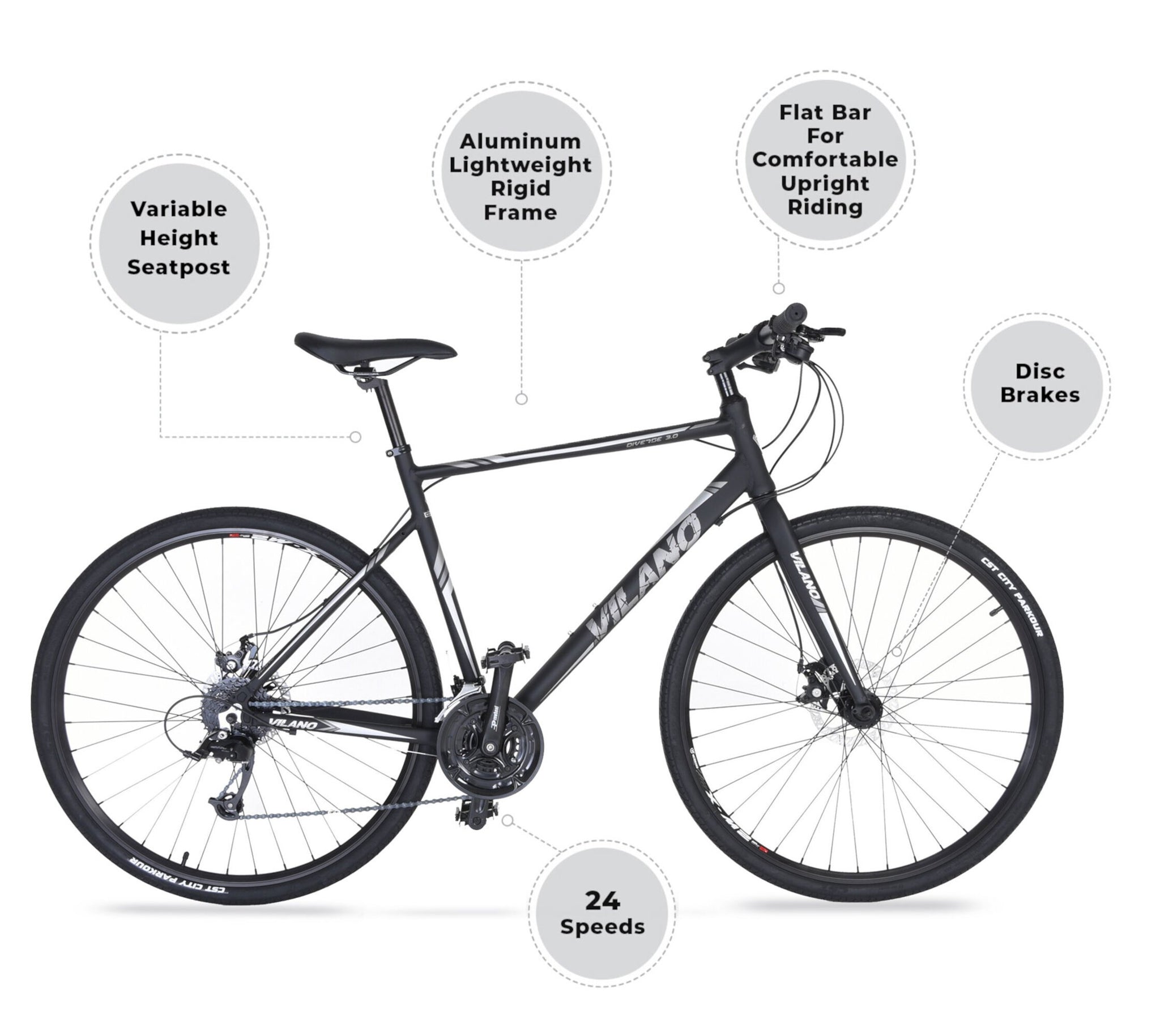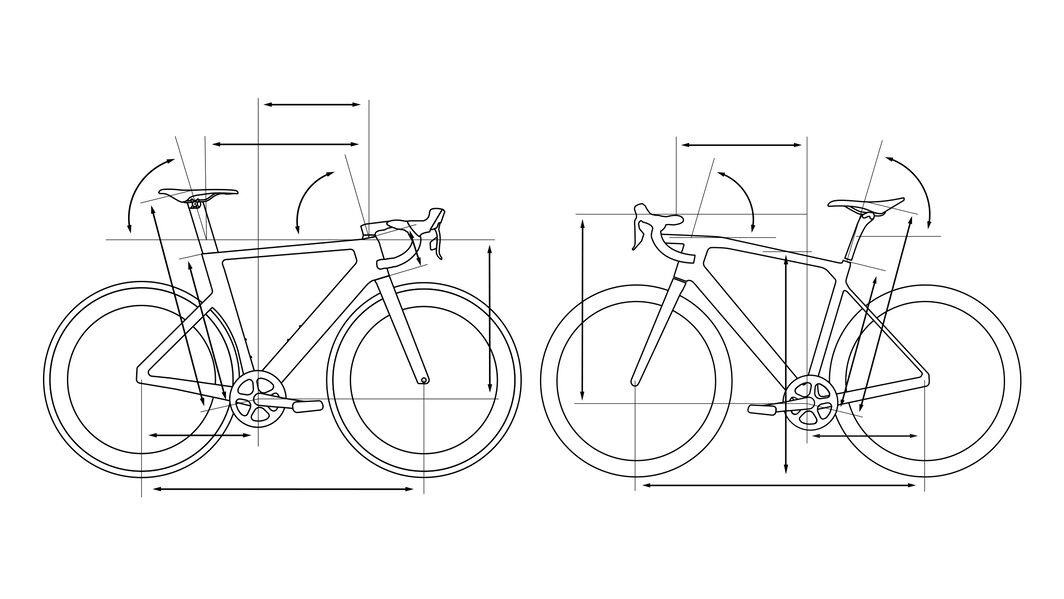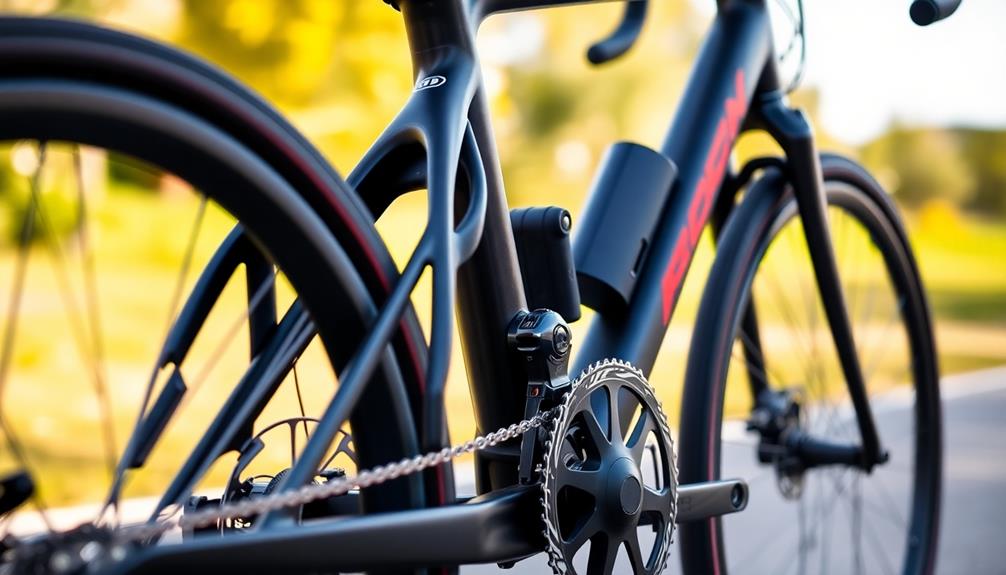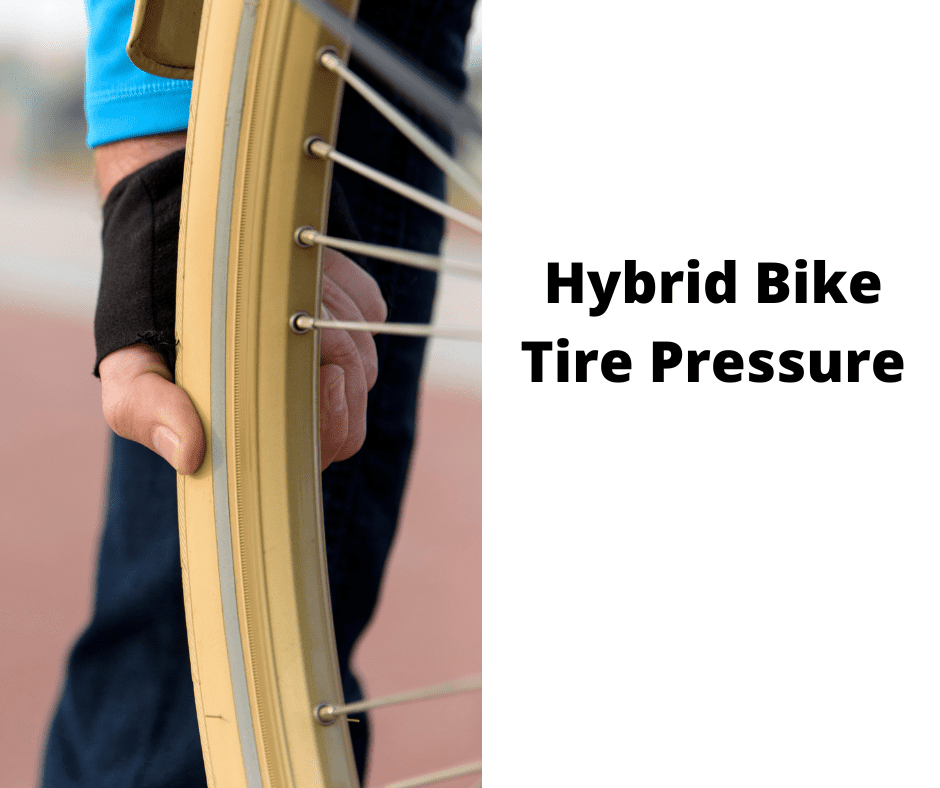When examining the differences between road bikes and hybrid bikes, it’s essential to note that their design and purpose significantly impact their speed potential. Below is a comparison of how speed varies between road bikes and hybrid bikes:
Road Bike:
- Aerodynamics: Road bikes have an aggressive geometry that promotes a forward-leaning riding position, reducing air resistance and increasing aerodynamic efficiency.
- Weight: Road bikes are generally lighter than hybrid bikes due to their frame materials and components, making them quicker to accelerate and easier to carry uphill.
- Wheels and Tires: Road bikes use narrow, high-pressure tires (usually 23mm-28mm wide) and lightweight rims, which provide less rolling resistance and faster speeds on paved surfaces.
- Gearing: Road bikes have a wider range of high gears, allowing for higher top speeds on flat terrain and descents.
- Handlebars: The drop handlebars on road bikes offer multiple hand positions, providing a more aerodynamic riding position and greater control at high speeds.
- Aerodynamics: Hybrid bikes have a more upright geometry, which is comfortable for casual riding but less aerodynamic than road bikes, leading to increased air resistance and slower speeds.
- Weight: Hybrid bikes are generally heavier than road bikes due to their sturdier frames and versatile components, which can reduce acceleration and climbing efficiency.
- Wheels and Tires: Hybrid bikes have wider tires (usually 28mm-45mm wide) that provide more stability and comfort on a variety of surfaces but create more rolling resistance, resulting in slower speeds on paved roads.
- Gearing: Hybrid bikes often have a wider range of low gears, designed for easier pedaling on hills and varied terrain, but may lack the high gears needed for maximum speed on flat surfaces.
- Handlebars: Hybrid bikes usually feature flat or riser handlebars, which allow for an upright riding position and easy control, but limit aerodynamic efficiency.
| Feature | Road Bike | Hybrid Bike |
|---|---|---|
| Aerodynamics | Aggressive geometry, forward-leaning position | Upright geometry, comfortable position |
| Weight | Lighter weight for faster acceleration | Heavier weight for stability and versatility |
| Wheels and Tires | Narrow (23-28mm), high-pressure tires | Wider (28-45mm) tires for varied surfaces |
| Gearing | Wide range of high gears for top speeds | Wide range of low gears for varied terrain |
| Handlebars | Drop handlebars for aerodynamics | Flat or riser handlebars for easy control |
In summary, road bikes are generally faster than hybrid bikes due to their aerodynamic design, lighter weight, and more efficient wheels and tires. However, hybrid bikes offer versatility and comfort for a wide range of riding conditions. Choose a road bike if speed and performance on paved roads are your top priorities, and opt for a hybrid bike if you prioritize comfort, versatility, and the ability to ride on various surfaces.
If you’re deciding between a road bike and a hybrid speed, you may wonder which is better. Here are the factors to consider when deciding between the two types of bikes. Performance and comfort are key, but you can’t go wrong with either one. If you’re still unsure, keep reading to find out the pros and cons of each type of bike. You might also be interested in learning how to choose the best hybrid bike for you.
Choosing Between a Road Bike and A Hybrid Speed
If you want to enjoy cycling, you should decide which type of bike best suits your needs. Both road bikes and hybrid bikes have their unique advantages. To help you make the right choice, here are some advantages of each type:
The weight of each bike is different. A road bike typically weighs less than 10 pounds. A hybrid speed bike rarely weighs more than 20 pounds. A hybrid bike’s frame materials are generally less durable than those of road bikes. The weight difference is due to the components used to make the frame. Hybrid speed bikes generally have a higher weight and are designed with racing in mind. They are also more difficult to adjust to different riding styles.
A road bike is more powerful and faster than a hybrid. It is also built for comfort, allowing you to pedal at a lower speed for longer distances. The gears on a road bike are also smaller than those of a hybrid, allowing you to pedal at a higher cadence at lower speeds. The biggest gear on a hybrid is 45Tx11T, while road bikes feature 53Tx11T. This means that you will get the same pedal cadence on a hybrid, but will be able to reach 8.5 km/h faster on a road bike.
Choosing between a road bike and a hybrid speed should be a matter of personal preference and the type of riding you do. Road bikes are generally lighter, faster, and aerodynamic than hybrids, but they can only handle smooth surfaces and dry conditions. On the other hand, hybrids can handle slick surfaces and rocky terrain. The difference in price between the two types of bikes is often negligible.
If you are a beginner, choosing between a road bike and a hybrid is often confusing. Road bikes are often faster and lighter than hybrids, but the geometry is not always the same. The two types of bikes are fundamentally different. The geometry of the road bike affects the comfort of the rider. Road bikes are more aerodynamic and have low bottom brackets, but you should consider the comfort of your ride before deciding which one to buy.
Factors to Consider when Buying a Hybrid Bike
When buying a hybrid bike, you’ll want to look for several key factors. Each bike has unique features and performance, and each model will suit your riding needs in different ways. Here are some of the most important factors to consider when shopping for a hybrid bike. First, consider the type of terrain you’ll be riding on, because different types of terrain require different speeds. Secondly, you’ll want to consider whether you’ll be commuting or exercising on your hybrid bike.
Another important feature to look for is the gearing system. Some hybrid bikes have 27 gears, but many don’t. While the most popular bikes have a single gear, others are equipped with two or three. In addition, the gear adjuster is on the handlebar, which can be confusing if you’re unfamiliar with the different types of gearing systems. Fortunately, there’s an easy way to determine which gears your hybrid bike needs.
When choosing a hybrid bike, it’s also important to consider the size of your body. Road bikes are much more aggressive and aerodynamic, while hybrid bikes are designed to be comfortable and provide balance. This means that if you’re a shorter rider, your hybrid bike will be more comfortable for you. While hybrid bikes are smaller than road bikes, they’re still large enough to hold you upright and reduce the risk of injury.
In addition to choosing the right size, make sure you consider what type of riding you plan to do. Some bikes have suspension seatposts, which will help you ride on rougher terrain. Some hybrids even have drop bars, which can be difficult for novice cyclists. Depending on how and where you plan to ride, you might want a hybrid that comes with a suspension system. A suspension system will help you change gears more easily and comfortably.
Performance
In terms of speed performance, road bikes are clearly better than hybrids. They are lighter and have lightweight structures. Unlike hybrids, road bikes have drop handlebars that are separate from the rest of the bike. Road bikes are also better suited for paved terrain and are less susceptible to wind resistance. They can also handle a wider variety of terrain, such as rough terrain. The overall weight of the bike also plays a factor in speed.
The geometry of both road and hybrid bikes plays a role in determining speed. Road bikes typically feature carbon fiber frames, which are among the lightest on the market. On the other hand, hybrid bikes are made of aluminum, which adds about a half pound to the total weight of the bike. While this difference may seem small, it can make a big difference when you are pedaling long distances.
While both types of bikes are fast, road bikes aren’t as versatile as hybrids on the roughest terrain. They have narrow tires, which make them more susceptible to punctures and can be harder to ride on rocky terrain. In addition, road bikes tend to have smaller frames, while hybrids tend to have longer frames. Shorter stacks and longer reaches are also advantageous in terms of aerodynamics. However, a shorter reach means that the rider is generally in a lower position than a hybrid. Hybrid bikes often feature dropped handlebars as well.
If you’re riding long distances, you might want to consider a hybrid or a road bike for your long-distance journey. The advantages of a hybrid are often more obvious than the differences in speed and versatility. Road bikes are better at paved roads, while hybrids are built to handle rougher terrain. Hybrids have less weight and more usability. And while road bikes are more expensive, they’re also more versatile.
While you can’t increase speed in a hybrid by raising the saddle, you can easily make your bike faster by upgrading certain components. For example, you can lower the handlebars, install narrower tires, and increase the air pressure in the tires. In addition, you can also increase the speed of your hybrid by replacing the tires with lower rolling resistance tires. But, you should consider the weight of the bike, as too much gear may restrict your speed.
Comfort
One major difference between a comfort bike and a speed hybrid is the seat level. The lower the seat is, the less comfortable it will be. Most hybrids are set up this way, but some may be designed for occasional off-road riding. Another major difference between the two types is the position of the pedals. The latter are more aerodynamic and can provide the rider with more power for pedaling.
A hybrid bike is a better choice if you’re not a road racer, as its flat bars are more comfortable for your back. Road bikes are generally more aggressive and aerodynamic than hybrids, so they are suited for more extreme terrain. While road bikes can handle rough terrain, many are not ideal for long distances. Hybrid bikes are designed for cultivated terrain. Road bikes are not designed for mountain biking.
When choosing a bike, many cyclists are concerned about comfort, which is why many people opt for the former. Road bikes are designed for an upright position, which helps the rider lean forward over the bottom bracket and sit upright when pedalling. A hybrid’s frame geometry is designed to allow the rider to lean forward over the bottom bracket, which allows the bike to distribute the rider’s weight evenly across the frame. The top tube length of a hybrid bike is typically shorter than that of a road bike. This helps keep the rider’s weight more evenly distributed across the frame and seat.
The benefits of a road bike are numerous. Most riders are 20% faster on a road bike than on a hybrid, which can save them minutes on a short commute. Hybrids are lightweight and easy to handle. In addition to speed, they offer comfort. And the upright riding position means that they don’t cause back pain. Although a hybrid is more comfortable and easy to control, it requires some ride adjustment.
Regarding speed and maneuverability, the hybrid is more comfortable, as it allows for more accessories. The gearing is also more variable, which makes it easier to maneuver the hybrid in crowded conditions. Hybrids have better control over their speed in heavy traffic, making them more versatile than their road counterparts. For some people, a road bike may be more comfortable. The speed advantage is greater as a result of more aerodynamic design.










